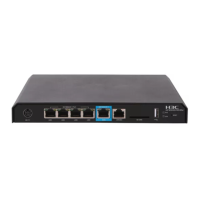31
Configuring traffic filtering
You can filter in or filter out traffic of a class by associating the class with a traffic filtering action. For
example, you can filter packets sourced from an IP address according to network status.
Configuration procedure
To configure traffic filtering:
1. Enter system view.
system-view
N/A
2. Create a traffic class and
enter traffic class view.
traffic classifier
classifier-name
[
operator
{
and
|
or
} ]
By default, no traffic class
exists.
3. Configure match criteria.
if-match
[
not
]
match-criteria
By default, no match criterion
is configured.
4. Return to system view.
quit
N/A
5. Create a traffic behavior
and enter traffic behavior
view.
traffic behavior
behavior-name
By default, no traffic behavior
exists.
6. Configure the traffic
filtering action.
filter
{
deny
|
permit
}
By default, no traffic filtering
action is configured.
7. Return to system view.
quit
N/A
8. Create a QoS policy and
enter QoS policy view.
qos policy
policy-name
By default, no QoS policy
exists.
9. Associate the traffic class
with the traffic behavior in
the QoS policy.
classifier
classifier-name
behavior
behavior-name
By default, a traffic class is not
associated with a traffic
behavior.
10. Return to system view.
quit
N/A
11. Apply the QoS policy to
an interface.
Applying the QoS policy to an interface
By default, no QoS policy is
applied to an interface.
12. (Optional.) Display the
traffic filtering
configuration.
display traffic behavior
{
system-defined
|
user-defined
}
[ behavior-name ] [
slot
slot-number ]
Available in any view.
Configuration example
Network requirements
As shown in Figure 7, configure traffic filtering on GigabitEthernet 1/0/1 to deny the incoming packets
with a source port number other than 21.

